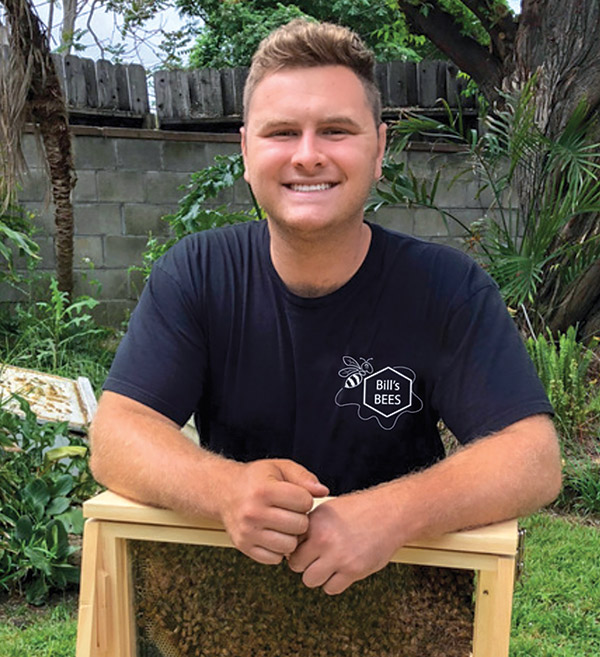Bees are his business

May/June 2023 California Bountiful magazine

Fascination, compassion for insect inspired Jeremy Jensen’s career
Story by Christine Souza
Photo courtesy of Jeremy Jensen
Honey, a natural sweetener swirled into beverages, drizzled over desserts or added to entrées, is the product of hard work by honeybees and beekeepers.
Many commercial apiarists are born into the nomadic business of beekeeping. But this sector of agriculture has seen a renaissance of sorts as hobbyists, nature lovers and entrepreneurs buzz into the game.
As a teenager, Jeremy Jensen was looking for adventure. He found it in bees.
“I remember being on a crane and being lowered down over a wall in the Hollywood Hills to reach the bees and I’m looking over this beautiful view of all of Los Angeles,” he recalls. “We must have harvested four or five boxes of honey.”
It wasn’t just the adrenaline rush and beekeeper suit that led Jensen to bees. The plight of the honeybee due to a phenomenon known worldwide as colony collapse disorder, in which bees leave the hive and do not return, tugged at his heartstrings.
“I wanted to help save the bees and maybe turn the bees into a business,” he says. Today Jensen owns JJJ Bees and Bill’s Bees, both of which sell honey at farmers markets and rent honeybees for pollination.
Getting started
As a teen, Jensen took classes through the local beekeepers association and met mentors including beekeeper Bill Lewis, who offered him a job. One beehive led to another, and by the time Jensen turned 16, he was managing 50 colonies. A few years later, after earning a bachelor’s degree in business management, he owned JJJ Bees and had 400 hives. In 2021, when Lewis retired, Jensen jumped at the chance to purchase Bill’s Bees.
The honeybees’ job
Traveling from flower to flower, bees gather nectar to create honey and pollinate crops such as almonds, alfalfa, blueberries, cherries, kiwi fruit and melons. By early February each year, Jensen moves bees to blooming almond orchards and later heads to the coast to pollinate avocados. To create honey with a pungent, aromatic flavor, bees are placed in coastal avocado groves. For a hint of orange blossom, bees are set in self-pollinating citrus.
Technology and TLC
Jensen is experimenting with thermal imaging to avoid disturbing the bees while he inspects their hives. He says the technology offers a picture of the health of each hive without having to open it. Late in the year, to keep the bees from experiencing a harsh winter, Jensen places them in the high desert to shut down brood production. “We really like how the bees looked, having a little break.”
Ongoing challenges
Caring for honeybees is not easy. “Beekeepers have massive losses every year. On average, a beekeeper loses 30% of their colonies,” Jensen says. “It’s an enormous hit and we’re always trying to recoup that and it’s through no fault of a beekeeper.” Ongoing challenges such as poor nutrition due to drought and an invasive species known as the Varroa mite have led to the falling bee numbers.
Keeping bees healthy
Honeybees with a variety of pollen and nectar sources can better fight off stressors. With drought conditions and less forage on the landscape, Jensen says, it becomes more important to have places where bees can access nutrition. “One of the biggest problems we have is finding places to put the bees to get good food,” Jensen says. He suggests that the government expand beekeepers’ access to public lands.
Worth every sweet drop
Some customers balk at his $14-a-pound price for honey, Jensen says, but that helps him keep the bees healthy, pay employees and purchase supplies. His businesses bottle honey, manage some distribution and sell at six Southern California farmers markets. There, he interacts with celebrities and other fans of his honey. Personally, he says, “I love honey in my yogurt and in my cereal.”

